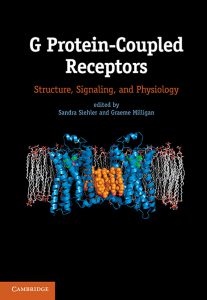G protein-coupled receptors : structure, signaling, and physiology
AUTHOR : –
CALL NO : QU55.7 G111 2011
IMPRINT : Cambridge : Cambridge University Press, c2011
This text provides a comprehensive overview of recent discoveries and current understandings of G protein-coupled receptors (GPCRs). Recent advances include the first mammalian non-rhodopsin GPCR structures and reconstitution of purified GPCRs into membrane discs for defined studies, novel signaling features including oligomerization, and advances in understanding the complex ligand pharmacology and physiology of GPCRs, in new assay technologies and drug targeting. The first chapters of this book illustrate the history of GPCRs based on distinct species and genomic information. This is followed by discussion of the homo- and hetero-oligomerization features of GPCRs, including receptors for glutamate, GABAB, dopamine, and chemokines. Several chapters are devoted to the key signaling features of GPCRs. The authors take time to detail the importance of the pathophysiological function and drug targeting of GPCRs, specifically adrenoceptors in cardiovascular and respiratory diseases, metabotropic glutamate receptors in CNS disorders, S1P receptors in the immune system, and Wnt/Frizzled receptors in osteoporosis. This book will be invaluable to researchers and graduate students in academia and industry who are interested in the GPCR field.
- Provides a broad overview of G-protein coupled receptors (GPCRs), including the first mammalian non-rhodopsin GPCR structures, as well as the techniques used to study them
- Discusses GPCRs as drug targets – GPCRs constitute the single superfamily of proteins most targeted by currently marketed drugs
- Covers pathophysiological function of GPCRs, specifically in cardiovascular and respiratory diseases, central nervous system disorders, the immune system and in osteoporosis




